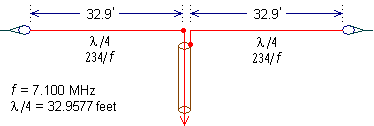| Inverted Dipole |
The inverted dipole is a very popular antenna. It's also known as a Inverted "V" antenna. The inverted antenna is a horizontal dipole with the ends tilted down to the ground. The angle between the two legs us usually between 90 and 120 degrees. A typical horizonal dipole for 40 meters would look like this;
Due to the effects of the elements against each other, as well as ground, it's always been a practice to shorten the length of each wire by 3-6 inches. (More for lower frequencies than higher). In our example we can see that each 1/4 wavelength wire in our horizontal dipole is 32.9' long. But when designing it as an inverted dipole, on 7.100 megahertz, it was necessary to shorten it by 3".
The dipole ends are usually, at minimim, 24" above the ground. Having the ends close to ground causes impedance artifacts and degrades performance. When installing this antenna it would be handy to have a VSWR meter or a way to measure the power reflected or the impedance of the antennt. In practice, the antenna feed point impedance will drop non-proportionally as the wires get closer to each other or ground. An installation at less than 90 degrees from each other is not recommended. Usually a better match is made with a 50 ohm transmission line rather than a 75 ohm transmission line. And keep in mind that the transmission line should be multiples of 1/2 wavelength at operating frequency. The performance of the inverted dipole is spread out, and less directional than the conventional horizonal dipole. However, gain is reduced. And due to thee characteristics and interaction with ground, this is a very good antenna for 40 and 80 meter communications. Here's a bonus! Using insulators on your tower, and a high-grade "aircraft cable" wire, you can actually use this antenna as guy wires!
Coming off the tower, place an insulator 6" off the leg. You will need about 18" of wire from a typical tower leg to the egg insulator. The wire for the antenna is then attached to the insulator, and goes toward the guy anchor, however, where the wire ends you place another insulator, then a wire that goes to the anchor. See figure 3. This can be done on 2 guy wires, or if you are innovative, do this with all three guy wires, and place a switching box up at the feed allowing you selection of any of the wires, which may favor a direction or null an offending signal. For example, if you have three wires, 1, 2, 3, you could use 1-2, 2-3, or 1-3. If the tower is high enough, you can also add a second level of inverted dipoles for up to 6 antennas! Also on a long guy run, it could be broken in two parts, with a trap in the center, so you have the top guys wires being (3) 40/80 meter inverted dipoles, while the bottom guys are (3) 20/40 meter inverted dipoles. |




No comments:
Post a Comment